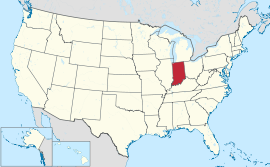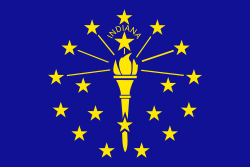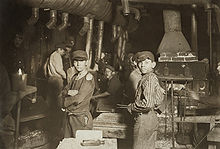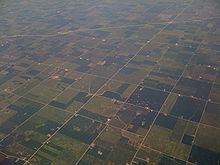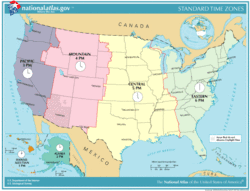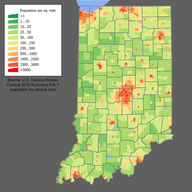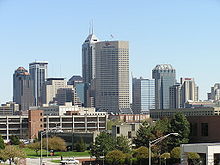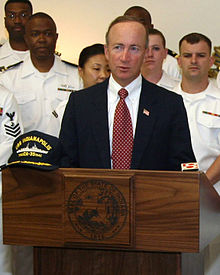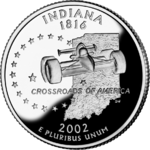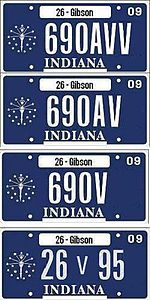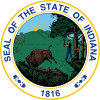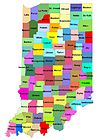- Indiana
-
"Hoosier State" redirects here. For the passenger train, see Hoosier State (train).
State of Indiana 

Flag Seal Nickname(s): The Hoosier State Motto(s): The Crossroads of America Official language(s) English Spoken language(s) General American English, Midwestern and
Southern English Dialects,
Other LanguagesDemonym Hoosier[1] Capital
(and largest city)Indianapolis Largest metro area Indianapolis metropolitan area Area Ranked 38th in the U.S. - Total 36,418 sq mi
(94,321 km2)- Width 140 miles (225 km) - Length 270 miles (435 km) - % water 1.5 - Latitude 37° 46′ N to 41° 46′ N - Longitude 84° 47′ W to 88° 6′ W Population Ranked 15th in the U.S. - Total 6,483,802 - Density 181/sq mi (69.79/km2)
Ranked 16th in the U.S.Elevation - Highest point Hoosier Hill[2][3]
1,257 ft (383 m)- Mean 700 ft (210 m) - Lowest point Confluence of Ohio River and Wabash River[2][3]
320 ft (97 m)Before statehood Indiana Territory Admission to Union December 11, 1816 (19th) Governor Mitchell E. Daniels, Jr. (R) Lieutenant Governor Becky Skillman (R) Legislature General Assembly - Upper house Senate - Lower house House of Representatives U.S. Senators Richard Lugar (R)
Dan Coats (R)U.S. House delegation 6 Republicans,
3 Democrats (list)Time zones - 80 counties Eastern UTC-5/-4 - 12 counties in
Evansville and
Gary Metro Areas
For more information,
see Time in IndianaCentral: UTC-6/-5 Abbreviations IN US-IN Website in.gov Indiana State symbols The Flag of Indiana. 
The Seal of Indiana. Animate insignia Bird(s) Cardinal Flower(s) Peony Tree Tulip tree Inanimate insignia Beverage Water Poem "Indiana" Slogan(s) Restart your Engines Soil Miami Song(s) "On the Banks of the Wabash, Far Away" Route marker(s) 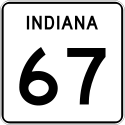
State Quarter 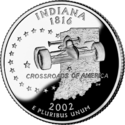
Released in 2002 Lists of United States state insignia Indiana
 i/ɪndiˈænə/ is a US state, admitted to the United States as the 19th on December 11, 1816. It is located in the Midwestern United States and Great Lakes Region. With 6,483,802 residents, the state is ranked 15th in population and 16th in population density.[4] Indiana is ranked 38th in land area and is the smallest state in the continental US west of the Appalachian Mountains. Its capital and largest city is Indianapolis, the second largest of any state capital and largest state capital east of the Mississippi River.
i/ɪndiˈænə/ is a US state, admitted to the United States as the 19th on December 11, 1816. It is located in the Midwestern United States and Great Lakes Region. With 6,483,802 residents, the state is ranked 15th in population and 16th in population density.[4] Indiana is ranked 38th in land area and is the smallest state in the continental US west of the Appalachian Mountains. Its capital and largest city is Indianapolis, the second largest of any state capital and largest state capital east of the Mississippi River.Before it became a territory, varying cultures of indigenous peoples and historic Native Americans inhabited Indiana for thousands of years. Angel Mounds State Historic Site, one of the best preserved ancient earthwork mound sites in the United States, can be found in Southwestern Indiana near Evansville.[5]
Residents of Indiana are known as Hoosiers. The derivation of the term is disputed, but one hypothesis has "Hoosier" originating from a frontier greeting, a corruption of "Who's here?" The state's name means "Land of the Indians," or simply "Indian Land." This name dates back to at least the 1760s but was first applied to the region by the United States Congress when the Indiana Territory was incorporated in 1800, separating it from the Northwest Territory.[6][7]
Today, Indiana has a diverse economy with a gross state product of $214 billion in 2005.[8] Indiana has several metropolitan areas with populations greater than 100,000 and a number of smaller industrial cities and towns. Indiana is home to several major sports teams and athletic events including the NFL's Indianapolis Colts, the NBA's Indiana Pacers, the WNBA’s Indiana Fever, and the Indianapolis 500 and Brickyard 400 motorsports races. The state also has several NCAA Division I athletic programs, notably the Purdue Boilermakers, Indiana Hoosiers, Notre Dame Fighting Irish, and Butler Bulldogs.
Furthermore, the state has several universities ranked among the best in U.S. News & World Report's 2011 rankings. Purdue University, Indiana University, and the University of Notre Dame are ranked among the top 50 in the National Universities Rankings, while Butler University, Valparaiso University and the University of Evansville are ranked among the top 10 in the Regional University Midwest Rankings.[9][10] Taylor University has been ranked first in the guide's America’s Best Colleges among 109 Midwest Regional Colleges for five years in a row.[11] Additionally, Rose-Hulman Institute of Technology has been rated the best undergraduate engineering program by the magazine since the year 2000.[12][13]
Contents
History
The first residents in what is now Indiana were the Paleo-Indians, ingressing about 8000 BC after the melting of the glaciers at the conclusion of the Ice Age. Divided into small groups, the Paleo-Indians were nomads who hunted large game such as Mastodons. They created stone tools made out of chert by chipping, knapping and flaking.[14] The subsequent phase of Indiana's Native American antiquity is called the Archaic period, which occurred between 5000 and 4000 BC. They differed from the Paleo-Indians in that they used new tools and techniques to prepare food. Such new tools included different types of spear points and knives, with various forms of notches. They also used ground stone tools such as stone axes, woodworking tools and grinding stones. During the latter part of the period, mounds and middens were created, indicating that their settlements were becoming more permanent. The Archaic period ended at about 1500 BC, although some Archaic people lived until 700 BC.[14] Afterwards, the Woodland period took place in Indiana, where various new cultural attributes appeared. During this period, ceramics and pottery were created as well as the increase of usage in horticulture. An early Woodland period group named the Adena people had elegant burial rituals, featuring log tombs beneath earth mounds. In the middle portion of the Woodland period, the Hopewell people began exploration of long-range trade of goods. Nearing the end of the stage, an exhaustive cultivation and adaptation of agriculture to grow crops such as corn and squash. The Woodland period ended around 1000 AD.[14] The incoming period afterwards was known as the Mississippian period, which lasted from 1000 until just before the arrival of Europeans. During this stage, large settlements were created that had similarities to towns, such as the Angel Mounds. They had large public areas such as plazas and platform mounds, where instrumental individuals of the settlement lived or conducted rituals. Mississippian civilization collapsed in Indiana during the mid-1400s for reasons that remain unclear.[14]
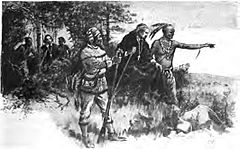 Native Americans guide French explorers through Indiana as depicted by Maurice Thompson in Stories of Indiana.
Native Americans guide French explorers through Indiana as depicted by Maurice Thompson in Stories of Indiana.
French explorer René-Robert Cavelier, Sieur de La Salle was the first European to cross into Indiana after reaching present-day South Bend at the Saint Joseph River in 1679.[15] He returned the following year to gain knowledge of northern Indiana. Canadiens fur traders also came along and brought blankets, jewelry, tools, whiskey and weapons to trade for skins with the Native Americans. By 1702, the first trading post was established by Sieur Juchereau near Vincennes. In 1715, Sieur de Vincennes built Fort Miami at Kekionga, now Fort Wayne. In 1717, another Canadien, Picote de Beletre, built Fort Ouiatenon on the Wabash River, with the efforts to control Native American trade routes from Lake Erie to the Mississippi River. In 1732, Sieur de Vincennes built a second fur trading post at Vincennes. Canadien settlers, which had left the earlier post because of hostilities, came back in larger numbers. In a period of a few years however, the British arrived and contended against the Canadians for management of the fruitful fur trade. Fighting between the Canadians and British occurred throughout the 1750s as a result.
The Native American tribes of Indiana sided with the Canadians during the French and Indian War. By the conclusion of the war in 1763, the French had lost all land west of the colonies, and control had been ceded to the British crown. Neighboring tribes in Indiana, however, did not give up and destroyed Fort Ouiatenon and Fort Miami during Pontiac's Rebellion. The royal proclamation of 1763 ceded the land west of the Appalachians for Indian use, and was thus labeled Indian territory. In 1775, the American Revolutionary War began as the colonists looked to free themselves from British rule. The majority of the fighting took place in the east, but military officer George Rogers Clark called for an army to help fight the British in the west.[16] Clark's army won significant battles to overtake Vincennes and Fort Sackville on February 25, 1779.[17] During the war, Clark managed to cut off British troops who were attacking the colonist from the west. His success is often credited for changing the course of the American Revolutionary War.[18] At the end of the revolutionary war, through the treaty of Paris, the British crown ceded their claims to the land south of the Great Lakes to the newly formed United States.
Present-day Indiana became part of the Northwest Territory in 1787. In 1800, Ohio was separated from the Northwest Territory by Congress, designating the rest of the land as the Indiana Territory.[19] President Thomas Jefferson chose William Henry Harrison as the governor of the territory and Vincennes was established as the capital.[20] After Michigan was separated and the Illinois Territory was formed, the size of Indiana was reduced to its current state.[19] In 1810, Shawnee leader Tecumseh and his brother Tenskwatawa encouraged other tribes to resist European settlement into the territory. Tensions rose and Harrison was authorized to launch a preemptive expedition against Tecumseh's Confederacy resulting in a US victory at the Battle of Tippecanoe on November 7, 1811. Tecumseh was killed in 1813 during the Battle of Thames. After his death, armed resistance to United States control ended in the region. Most Native Americans in the state were later removed through negotiations to purchase their lands in the 1820s and 1830s.[21]
In December 1813, Corydon became the second capital of the Indiana Territory.[19] Two years later, a petition for statehood was approved by the territorial general assembly and sent to Congress. Afterwards, an Enabling Act was passed to provide an election of delegates to write a constitution for Indiana. On June 10, 1816, delegates assembled at Corydon to write the constitution, which was completed in nineteen days. President James Madison approved Indiana's admission into the union as the nineteenth state on December 11, 1816.[17] In 1825, the state capital was moved from Corydon to Indianapolis and 26 years later, a second constitution was adopted.[19] Following statehood, the new government set out on an ambitious plan to transform Indiana from a wilderness frontier into a developed, well-populated, and thriving state, beginning significant demographic and economic changes. The state's founders initiated a program that led to the construction of roads, canals, railroads and state-funded public schools. The plans bankrupted the state and were a financial disaster, but increased land and produce value more than fourfold.[22] The early nineteenth century saw much immigration to Indiana. The largest immigrant group to settle in Indiana were Germans, though there were also substantial amounts of immigrants from Ireland and England as well as Americans who were ethnically English from regions such as New York, New England and Pennsylvania.[23][24]
During the American Civil War, Indiana became politically influential and played an important role in the affairs of the nation. As the first western state to mobilize for the war, Indiana's soldiers were present in all of the major engagements during the war. Indiana residents were present in both the first and last battles and the state provided 126 infantry regiments, 26 batteries of artillery and 13 regiments of cavalry to the cause of the Union.[25] In 1861, Indiana was assigned a quota of 7,500 men to join the Union Army.[26] So many volunteered in the first call that thousands had to be turned away. Before the war ended, Indiana contributed 208,367 men to fight and serve in the war. Casualties were over 35% among these men: 24,416 lost their lives in the conflict and over 50,000 more were wounded.[27] The only Civil War battle fought in Indiana was the Battle of Corydon, which occurred during Morgan's Raid. The battle left 15 dead, 40 wounded, and 355 captured.[28]
Following the American Civil War, Indiana industry began to grow at an accelerated rate across the northern part of the state leading to the formation of labor unions and suffrage movements.[29] The Indiana Gas Boom led to rapid industrialization during the late 19th century by providing cheap fuel to the region.[30] In the early 20th century, Indiana developed into a strong manufacturing state with strong ties to the auto industry.[23] Haynes-Apperson, the nations first commercially successful auto company operated in Kokomo until 1925. The state also saw many developments with the construction of Indianapolis Motor Speedway and the start many other auto industries.[31] During the 1930s, Indiana, like the rest of the nation, was affected by the Great Depression. The economic downturn had a wide-ranging negative impact on Indiana, such as the decline of urbanization. The situation was aggravated by the Dust Bowl, which caused an influx of migrants from the rural Midwestern United States. Governor Paul V. McNutt's administration struggled to build a state-funded welfare system to help the overwhelmed private charities. During his administration, spending and taxes were both cut drastically in response to the depression and the state government was completely reorganized. McNutt also ended Prohibition in the state and enacted the state's first income tax. On several occasions, he declared martial law to put an end to worker strikes.[32] World War II helped lift the economy in Indiana, as the war required steel, food and other goods that were produced in Indiana.[33] Roughly 10 percent of Indiana's population joined the armed forces while hundreds of industries earned war production contracts and began making war material.[34] The effects of the war helped end the Great Depression.[33]
With the conclusion of World War II, Indiana rebounded to levels of production prior to the Great Depression. Industry became the primary employer, a trend that continued into the 1960s. Urbanization during the 1950s and 1960s led to substantial growth in the state's urban centers. The auto, steel and pharmaceutical industries topped Indiana's major businesses. Indiana's population continued to grow during the years after the war, exceeding five million by the 1970 census.[35] In the 1960s, the administration of Matthew E. Welsh adopted its first sales tax of two percent.[36] Indiana schools had been desegregated in 1949. Welsh also worked with the General Assembly to pass the Indiana Civil Rights Bill, granting equal protection to minorities in seeking employment.[37] Beginning in 1970, a series of amendments to the state constitution were proposed. With adoption, the Indiana Court of Appeals was created and the procedure of appointing justices on the courts was adjusted.[38] The 1973 oil crisis created a recession that hurt the automotive industry in Indiana. Companies like Delco Electronics and Delphi began a long series of downsizing that contributed to high unemployment rates in manufacturing in Anderson, Muncie, and Kokomo. The deindustrialization trend continued until the 1980s when the national and state economy began to diversify and recover.[39]
Geography
With a total area of 36,418 square miles (94,320 km2), Indiana ranks as the 38th largest state in size.[40] The state has a maximum dimension north to south of 250 miles (400 km) and a maximum east to west dimension of 145 miles (233 km).[41] The state is bordered on the north by Michigan, on the east by Ohio and on the west by Illinois.[42] The Ohio River separates Indiana from Kentucky on the southern border.[43] Indiana is one of eight states that make up the Great Lakes region.[44] The state includes two natural regions of the United States, the Central Lowland and the Interior Low Plateau.[45] The average altitude of Indiana is about 760 feet (230 m) above sea level.[46] The highest point in the state is Hoosier Hill, which is 1,257 feet (383 m) above sea level.[47] Only 2,850 square miles (7,400 km2) have an altitude greater than 1,000 feet (300 m) and this area is enclosed within 14 counties. About 4,700 square miles (12,000 km2) have an elevation of less than 500 feet (150 m).[48]
The till plains make up the central allotment of Indiana. Much of its appearance is a result of elements left behind by glaciers. The area includes some low hills and the soil is composed of glacial sands, gravel and clay, which results to exceptional farmland in central Indiana.[42] The unglaciated segment of the state carries a different and off-balance surface, characterized in places by profound valleys and expeditious streams. A limited area in the southeastern area of the state possesses these types of characteristics. The soil is fertile in the valleys of Indiana, most notably Whitewater Valley which is known for its prodigious farming. In northwest Indiana, there are various sand hills and dunes, due in some measure to a former extension of the lake and wind action. In the basin of the Kankakee River there is an extensive scope of lakes, marshes and prairies. In northeastern Indiana there is a region of tall moraines, one of which is 200 to 500 feet (61 to 150 m) deep, 25 miles (40 km) wide and stretching across a distance of 100 miles (160 km).[49]
The Wabash River, which is the longest free-flowing river east of the Mississippi, is the official river of Indiana.[50][51] At 475 miles (764 km) in length, the river bisects the state from northeast to southwest before flowing south, mostly along the Indiana-Illinois border. The river has been the subject of several songs, such as On the Banks of the Wabash, The Wabash Cannonball and Back Home Again, In Indiana.[52][53]
The Kankakee River passes through northern Indiana before emptying into the Illinois River and serves as a demarcating line between suburban northwest Indiana and the rest of the state.[54] There are over 1,000 lakes in Indiana.[55] Indiana borders Lake Michigan where the Port of Indiana operates the state's largest shipping port. Tippecanoe Lake is the deepest lake in the state reaching depths at nearly 120 feet (37 m) while Lake Wawasee is the largest natural lake in Indiana.[56]
Climate
Indiana has a humid continental climate, with cool winters and warm, irriguous summers.[57] The extreme southern portion of the state is within the humid subtropical climate area and receives more precipitation than other parts of Indiana.[42] Temperatures generally diverge from the north and south sections of the state. In the middle of the winter, average high/low temperatures range from around 30 °F/15 °F (−1 °C/-10 °C) in the far north to 39 °F/22 °F (4 °C/-6 °C) in the far south. In the middle of summer there is generally a little less variation across the state, as average high/low temperatures range from around 84 °F/64 °F (29 °C/18 °C) in the far north to 90 °F/69 °F (32 °C/21 °C) in the far south.[58] The record high temperature for the state was 116 °F (47 °C) set on July 14, 1936 at Collegeville. The record low was −36 °F (−38 °C) on January 19, 1994 at New Whiteland. The growing season typically spans from 155 days in the north and 185 days in the south. While droughts occasionally occur in the state, rainfall totals are administered relatively equally throughout the year. Precipitation totals range from 35 inches (89 cm) near Lake Michigan to 45 inches (110 cm) along the Ohio River, with the state average being 40 inches (100 cm). The annual snowfall in Indiana varies widely across the state, ranging from 80 inches (200 cm) in the northwest along Lake Michigan to 14 inches (36 cm) in the far south. Lake effect snow accounts for roughly half of the snowfall in northwest and northcentral Indiana, due to the effects of the moisture and relative warmth of Lake Michigan upwind. The mean wind speed is 8 miles per hour (13 km/h).[59] Indiana is one of the most tornado-prone states in the country, ranking sixth in a list by VorTek, an Alabama company. The city of South Bend was ranked the 14th most tornado-prone city in the country, ahead of cities such as Houston and Wichita.[60] The same company also published a list of the most tornado prone cities and states in April, with Indiana coming in first and South Bend ranking 16th.[61] Despite its vulnerability, Indiana is not a part of tornado alley.[60]
Average Precipitation in Indiana[62] Jan Feb Mar Apr May Jun Jul Aug Sep Oct Nov Dec Annum 2.48 2.27 3.36 3.89 4.46 4.19 4.22 3.91 3.12 3.02 3.44 3.13 41.49 Time zones
Indiana is one of thirteen U.S. states that is divided into more than one time zone. Indiana's time zones have fluctuated over the past century. At present most of the state observes Eastern Time; six counties near Chicago and six near Evansville observe Central Time. Debate continues on the matter.
Before 2006, most of Indiana did not observe daylight saving time (DST). Some counties within this area, particularly Floyd, Clark, and Harrison counties near Louisville, Kentucky, and Ohio and Dearborn counties near Cincinnati, Ohio, unofficially observed DST by local custom. Since April 2006 the entire state observes DST.
Geographic and statistical areas
Indiana is divided into 92 counties. Only one, Marion, is a consolidated city-county.
Important cities and towns
Indianapolis, the current capital of Indiana is the third capital in the history of the state. The territorial capitals were Vincennes and later Corydon which became the first state capital when Indiana became a state. The center of population in Indiana as well as the geographic center of Indiana are both located near Indianapolis.[citation needed] Indiana has four large metropolitan areas anchored by in-state cities; Pictured below are the cities larger than 55,000 in order of population with their most current population estimates from the 2010 United States Census.[63]
Major Cities (population > 100,000 and above)
Secondary Cities (population > 100,000 and under)
-
Indianapolis
829,718 -
Fort Wayne
253,691 -
Evansville
117,259 -
South Bend
101,168 -
Hammond
80,830 -
Bloomington
80,405 -
Gary
80,294 -
Carmel
79,191 -
Fishers
76,794 -
Muncie
70,085 -
Lafayette
67,140 -
Terre Haute
60,785
Demographics
Population
Historical populations Census Pop. %± 1800 2,632 — 1810 24,520 831.6% 1820 147,178 500.2% 1830 343,031 133.1% 1840 685,866 99.9% 1850 988,416 44.1% 1860 1,350,428 36.6% 1870 1,680,637 24.5% 1880 1,978,301 17.7% 1890 2,192,404 10.8% 1900 2,516,462 14.8% 1910 2,700,876 7.3% 1920 2,930,390 8.5% 1930 3,238,503 10.5% 1940 3,427,796 5.8% 1950 3,934,224 14.8% 1960 4,662,498 18.5% 1970 5,193,669 11.4% 1980 5,490,224 5.7% 1990 5,544,159 1.0% 2000 6,080,485 9.7% 2010 6,483,802 6.6% Source: 1910–2010[64] As of 2010, there were 6,483,802 people residing in the state. The population density was 181.0 persons per square mile. The racial makeup of the state was 84.3% White, 9.1% African American, 1.6% Asian, 2.0% from a biracial or multiracial background and 0.3% Native American. Hispanic or Latino of any race made up 6.0% of the population.[65] The Hispanic population is Indiana’s fastest growing minority.[66] In the state, 24.9% of the population are under the age of 18, 6.9% are under the age of five and 12.8% are 65 years of age or older.[65] The median age is 36.4 years.[66] In 2005, 77.7% of Indiana residents lived in metropolitan counties, 16.5% lived in micropolitan counties and 5.9% lived in non-core counties.[67]
German is the largest ancestry reported in Indiana, with 22.7% of the population reporting that ancestry in the Census. Persons citing American (12.0%) and English ancestry (8.9%) are also numerous, as are Irish (10.8%) and Polish (3.0%).[68] Most of those citing American ancestry are actually of English descent, but have family that has been in North America for so long, in many cases since the early colonial era, that they identify simply as "American".[69][70][71][72] In the 1980 census 1,776,144 people claimed German ancestry, 1,356,135 claimed English ancestry and 1,017,944 claimed Irish ancestry out of a total population of 4,241,975 making the state 42% German, 32% English and 24% Irish.[73].
The center of population of Indiana is located in Hamilton County, in the town of Sheridan.[74] Population growth since 1990 has been concentrated in the counties surrounding Indianapolis, with four of the top five fastest-growing counties in that area: Hamilton, Hendricks, Johnson, and Hancock. The other county is Dearborn County, which is near Cincinnati. Hamilton County has also been the fastest growing county in the area consisting of Indiana and its bordering states of Illinois, Michigan, Ohio and Kentucky and the 20th fastest growing county in the country.[75]
In 2005, the median household income for Indiana residents was $43,993. Nearly 498,700 Indiana households had incomes from $50,000 to $74,999, accounting for 20% of all households. Hamilton County’s median household income is nearly $35,000 higher than the Indiana average. At $78,932, it ranks seventh in the country among counties with less than 250,000 people. The next highest median incomes in Indiana are also found in the Indianapolis suburbs; Hendricks County has a median of $57,538, followed by Johnson County at $56,251.[76]
Demographics of Indiana (csv) By race White Black AIAN* Asian NHPI* 2000 (total population) 90.13% 8.91% 0.65% 1.21% 0.08% 2000 (Hispanic only) 3.31% 0.15% 0.07% 0.03% 0.02% 2005 (total population) 89.57% 9.42% 0.63% 1.44% 0.08% 2005 (Hispanic only) 4.29% 0.19% 0.08% 0.04% 0.02% Growth 2000–05 (total population) 2.51% 8.99% -0.26% 23.11% 11.31% Growth 2000–05 (non-Hispanic only) 1.33% 8.68% -2.87% 22.97% 9.77% Growth 2000–05 (Hispanic only) 33.38% 26.82% 21.02% 28.42% 16.70% * AIAN is American Indian or Alaskan Native; NHPI is Native Hawaiian or Pacific Islander Religion
St. Meinrad Archabbey, located in the town of St. Meinrad in northeastern Spencer County, Indiana, is one of only two archabbeys in the United States and one of 11 in the world.
Although the largest single religious denomination in the state is Roman Catholic (836,009 members), most of the population are members of various Protestant denominations. The largest Protestant denomination by number of adherents in 2000 was the United Methodist Church with 288,308.[77] A study by the Graduate Center found that 20 percent are Roman Catholic, 14 percent belong to different Baptist churches, 10 percent are other Christians, nine percent are Methodist, and six percent are Lutheran. The study also found that 16 percent are secular.[78]
Indiana is home to the St. Meinrad Archabbey, one of two archabbeys in the United States and one of 11 in the world. The Lutheran Church-Missouri Synod has one of its two seminaries in Fort Wayne, IN. Two conservative denominations, the Free Methodist Church and the Wesleyan Church, have their headquarters in Indianapolis as does the Christian Church.[79][80] The Fellowship of Grace Brethren Churches maintains offices and publishing work in Winona Lake.[81] Huntington serves as the home to the Church of the United Brethren in Christ.[82] Anderson is home to the headquarters of the Church of God.[83] The headquarters of the Missionary Church is located in Fort Wayne.[84] The Friends United Meeting of the Religious Society of Friends, the largest branch of American Quakerism, is based in Richmond,[85] which also houses the oldest Quaker seminary in the United States, the Earlham School of Religion.[86] The Islamic Society of North America is headquartered in Plainfield.[87] Indiana has 100,000 Muslims and 17,000 Jews.
Cities and towns
With a population of 829,817, Indianapolis is by far the largest city in Indiana and 11th largest in the United States (when looking at its consolidated population within Marion County), according to the 2010 Census. Three other cities in Indiana have a population greater than 100,000: Fort Wayne (253,617), Evansville (179,703) and South Bend (101,168). Since 2000, Fishers has seen the largest population rise amongst the state’s 20 largest cities with an increase of 100 percent. Hammond and Gary have seen the largest population declines regarding the top 20 largest cities since 2000, with a decrease of 6.8 and 21.0 percent respectively.[88] Other cities that have seen extensive growth since 2000 are Noblesville (39.4 percent), Greenwood (81 percent), Carmel (21.4 percent) and Lawrence (9.3 percent). Meanwhile, Evansville (−4.2 percent), Anderson (−4 percent) and Muncie (−3.9 percent) are cities that have seen the steepest decline in population in the state.[89] Indianapolis has the largest metropolitan area in the state and 33rd largest in the country.[90] It consists of Marion County and eight surrounding counties in central Indiana.[91] Altogether there are 13 metropolitan areas in Indiana.[92]
Law and government
See also: United States congressional delegations from Indiana, Indiana's congressional districts, and Political party strength in IndianaThe Governor of Indiana serves as the chief executive of the state and has the authority to manage the government as established in the Constitution of Indiana. The governor and the lieutenant governor are jointly elected to four-year terms, with gubernatorial elections running concurrent with United States presidential elections (1996,2000,2004,2008, etc.).[93] The governor may not serve more than two consecutive terms. The governor works with the Indiana General Assembly and the Supreme Court of Indiana to govern the state and has the authority to adjust the other branches. Special sessions of the General Assembly can be called upon by the governor as well as have the power to select and remove leaders of nearly all state departments, boards and commissions. Other notable powers include calling out the Indiana Guard Reserve or the Indiana National Guard in times of emergency or disaster, issuing pardons or commuting the sentence of any criminal offenders except in cases of treason or impeachment and possessing an abundant amount of statutory authority.[93][94][95] The lieutenant governor serves as the President of the Senate and is responsible for ensuring that the senate rules are acted in accordance with by its constituents. The lieutenant governor can only vote to break ties. If the governor dies in office, becomes permanently incapacitated, resigns or is impeached, the lieutenant governor becomes governor. If both the governor and lieutenant governor positions are unoccupied, the Senate President pro tempore becomes governor.[96]
The Indiana General Assembly is composed of a 50-member Senate and 100-member House of Representatives. The Senate is the upper house of the General Assembly and the House of Representatives is the lower house.[93] The General Assembly has exclusive legislative authority within the state government. Both the Senate and House of Representatives can introduce legislation, with the exception that the Senate is not authorized to initiate legislation that will affect revenue. Bills are debated and passed separately in each house, but must be passed by both houses before they can submitted to the Governor.[97] The legislature can nullify a veto from the governor with a majority vote of full membership in the Senate and House of Representatives.[93] Each law passed by the General Assembly must be used without exception to the entire state. The General Assembly has no authority to create legislation that targets only a particular community.[97][98] The General Assembly can manage the state's judiciary system by arranging the size of the courts and the bounds of their districts. It also can oversee the activities of the executive branch of the state government, has restricted power to regulate the county governments within the state, and has exclusive power to initiate the method to alter the Indiana Constitution.[97][99]
The Indiana Supreme Court is made up of five judges with a Court of Appeals composed of 15 judges. The governor selects judges for the supreme and appeal courts from a group of applicants chosen by a special commission. After serving for two years, the judges must acquire the support of the electorate to serve for a 10-year term.[93] In nearly all cases, the Supreme Court does not have original jurisdiction and can only hear cases that are petitioned to the court following being heard in lower courts. Local circuit courts are where the majority of cases begin with a trial and the consequence decided by the jury. The Supreme Court does have original and sole jurisdiction in certain specific areas including the practice of law, discipline or disbarment of Judges appointed to the lower state courts, and supervision over the exercise of jurisdiction by the other lower courts of the State.[100][101]
The state is divided into 92 counties, which are led by a board of county commissioners. 90 counties in Indiana have their own circuit court with a judge elected for a six-year term. The remaining two counties, Dearborn and Ohio, are combined into one circuit. Many counties operate superior courts in addition to the circuit court. In densely populated counties where the caseload is traditionally greater, separate courts have been established to solely hear either juvenile, criminal, probate or small claims cases. The establishment, frequency and jurisdiction of these additional courts varies greatly from county to county. There are 85 city and town courts in Indiana municipalities, created by local ordinance, typically handling minor offenses and not considered courts of record. County officials that are elected to four-year terms include an auditor, recorder, treasurer, sheriff, coroner and clerk of the circuit court. All incorporated cities in Indiana have a mayor and council form of municipal government. Towns are governed by a town council and townships are governed by a township trustee and advisory board.[93][102]
Politics
Presidential elections results[103] Year Republican Democratic 2008 48.83% 1,345,648 49.86% 1,374,039 2004 59.94% 1,479,438 39.26% 969,011 2000 56.65% 1,245,836 41.01% 901,980 1996 47.13% 1,006,693 41.55% 887,424 1992 42.91% 989,375 36.79% 848,420 1988 59.84% 1,297,763 39.69% 860,643 1984 61.67% 1,377,230 37.68% 841,481 1980 56.01% 1,255,656 37.65% 844,197 1976 53.32% 1,183,958 45.70% 1,014,714 1972 66.11% 1,405,154 33.34% 708,568 1968 50.29% 1,067,885 37.99% 806,659 1964 43.56% 911,118 55.98% 1,170,848 1960 55.03% 1,175,120 44.60% 952,358 From 1880 to 1924, a resident of Indiana was included in all but one presidential election. Indiana Representative William Hayden English was nominated for Vice-President and ran with Winfield Scott Hancock in the 1880 election.[104] In 1884, former Indiana Governor Thomas A. Hendricks was elected Vice-President of the United States. He served until his death on November 25, 1885, under President Grover Cleveland.[105] In 1888, Indiana Senator Benjamin Harrison was elected President of the United States and served one term. He remains the only U.S. President from Indiana. Indiana Senator Charles W. Fairbanks was elected Vice-President in 1904, serving under President Theodore Roosevelt until 1913.[106] Fairbanks made another run for Vice-President with Charles Evans Hughes in 1912, but they both lost to Woodrow Wilson and Indiana Governor Thomas R. Marshall, who served as Vice-President from 1913 until 1921.[107] Not until 1988 did another presidential election involved a native of Indiana, when Senator Dan Quayle was elected Vice-President and served one term with George H. W. Bush.[42]
Indiana has long been considered to be a Republican stronghold,[108][109] particularly in Presidential races, but the Cook Partisan Voting Index (CPVI) now rates Indiana as only R+5, a smaller Republican edge than is assigned to 20 of the 28 "red" states. Indiana was one of only ten states to support Republican Wendell Willkie in 1940.[42] On 14 occasions has the Republican candidate defeated the Democrat by a double digit margin in the state, including six times where a Republican won the state by more than 20%.[110] In 2000 and 2004, George W. Bush won the state by a wide margin while the election was much closer overall. The state has only supported a Democrat for president five times since 1900. In 1912, Woodrow Wilson became the first Democrat to win the state with 43% of the vote. 20 years later, Franklin D. Roosevelt won the state with 55% of the vote over incumbent Republican Herbert Hoover. Roosevelt won the state again in 1936. In 1964, 56% of voters supported Democrat Lyndon B. Johnson over Republican Barry Goldwater. 44 years later, Democrat Barack Obama narrowly won the state against John McCain 50% to 49%.[111]
While only five Democratic presidential nominees have carried Indiana since 1900, 11 Democrats were elected governor during that time. Before Mitch Daniels became governor in 2005, Democrats had held the office for 16 consecutive years. Indiana elects two senators and nine representatives to Congress. The state has 11 electoral votes in presidential elections.[110] Seven of the districts favor the Republican Party according to the CPVI rankings; there are currently six Republicans serving as representatives and three Democrats. Historically, Republicans have been strongest in the eastern and central portions of the state, while Democrats have been strongest in the northwestern part of the state. Occasionally, certain counties in the southern part of the state will vote Democratic. Marion County, Indiana's most populated county, supported the Republican candidates from 1968 to 2000, before backing the Democrats in the 2004 and 2008 elections. Indiana's second most populated county, Lake County, is a strong supporter of the Democratic party that has not voted for a Republican since 1972.[110] In 2005, the Bay Area Center for Voting Research rated the most liberal and conservative cities in the United States on voting statistics in the 2004 presidential election, based on 237 cities with populations of more than 100,000. Five Indiana cities were mentioned in the study. On the liberal side, Gary was ranked second and South Bend came in at 83. Regarding conservative cities, Fort Wayne was 44th, Evansville was 60th and Indianapolis was 82nd on the list.[112]
Military installations
Indiana used to be home to two major military installations, Grissom Air Force Base near Peru (realigned to an Air Force Reserve installation in 1994) and Fort Benjamin Harrison near Indianapolis, now closed, though the Department of Defense continues to operate a large finance center there (Defense Finance and Accounting Service).
Current active installations include Air National Guard fighter units at Fort Wayne, and Terre Haute airports (to be consolidated at Fort Wayne under the 2005 BRAC proposal, with the Terre Haute facility remaining open as a non-flying installation). The Army National Guard conducts operations at Camp Atterbury in Edinburgh, Indiana, helicopter operations out of Shelbyville Airport and urban training at Muscatatuck Urban Training Center. The Naval Surface Warfare Center Crane Division is in the southwest of the state and the Army's Newport Chemical Depot, which is now closed and turning into coal purifier plant. Also, Naval Operational Support Center Indianapolis is home to several Navy Reserve units, two Marine Reserve units, and a small contingent of active and full-time-support reserve personnel.
Economy
Main article: Economy of IndianaIn 2000, Indiana had a work force of 3,084,100.[113] The total gross state product in 2010 was $275.7 billion.[114] A high percentage of Indiana's income is from manufacturing.[115] The Calumet region of northwest Indiana is the largest steel producing area in the U.S. Indiana's other manufactures include pharmaceuticals and medical devices, automobiles, electrical equipment, transportation equipment, chemical products, rubber, petroleum and coal products, and factory machinery.
Despite its reliance on manufacturing, Indiana has been much less affected by declines in traditional Rust Belt manufactures than many of its neighbors. The explanation appears to be certain factors in the labor market. First, much of the heavy manufacturing, such as industrial machinery and steel, requires highly skilled labor, and firms are often willing to locate where hard-to-train skills already exist. Second, Indiana's labor force is located primarily in medium-sized and smaller cities rather than in very large and expensive metropolises. This makes it possible for firms to offer somewhat lower wages for these skills than would normally be paid. Firms often see in Indiana a chance to obtain higher than average skills at lower than average wages.[116]
Indiana is home to the international headquarters and research facilities of pharmaceutical company Eli Lilly in Indianapolis, the state's largest corporation, as well as the world headquarters of Mead Johnson Nutritionals in Evansville.[117] Overall, Indiana ranks fifth among all U.S. states in total sales and shipments of pharmaceutical products and second highest in the number of biopharmaceutical related jobs.[118]
Indiana is located within the U.S. Corn Belt and Grain Belt. The state has a feedlot-style system raising corn to fatten hogs and cattle. Along with corn, soybeans are also a major cash crop. Its proximity to large urban centers, such as Indianapolis and Chicago, assure that dairying, egg production, and specialty horticulture occur. Other crops include melons, tomatoes, grapes, mint, popping corn, and tobacco in the southern counties.[119] Most of the original land was not prairie and had to be cleared of deciduous trees. Many parcels of woodland remain and support a furniture-making sector in the southern portion of the state.
In 2011 Indiana was ranked first in the Midwest and sixth in the country for best places to do business according to CEO magazine.[120]
State budget
See also: Taxes in IndianaIndiana does not have a legal requirement to balance the state budget either in law or its constitution. Instead, Indiana has a constitutional ban on assuming debt. Indiana has a Rainy Day Fund and for healthy reserves proportional to spending. Indiana is one of the few states in the U.S. which do not allow a line-item veto. Indiana does not use Generally Accepted Accounting Principles.
Indiana has a flat state income tax rate of 3.4%. Many Indiana counties also collect income tax. The state sales tax rate is 7%. Property taxes are imposed on both real and personal property in Indiana and are administered by the Department of Local Government Finance. Property is subject to taxation by a variety of taxing units (schools, counties, townships, cities and towns, libraries), making the total tax rate the sum of the tax rates imposed by all taxing units in which a property is located. However, a "circuit breaker" law enacted on March 19, 2008 limits property taxes to one percent of assessed value for homeowners, two percent for rental properties and farmland and three percent for businesses.
In Fiscal year 2011 Indiana reported one of the largest surpluses among U.S states, with an extra $1.2 billion in its accounts. Gov. Mitch Daniels, a Republican, authorized bonus payments of up to $1,000 for state employees on Friday, July 15, 2011. An employee who “meets expectations” will get $500, those who “exceed expectations” will receive $750 and “outstanding workers” will see an extra $1,000 in their August paychecks[121]
Energy
Further information: List of Generating Stations in IndianaIndiana's power production chiefly consists of the consumption of fossil fuels, mainly coal. Indiana has 24 coal power plants, including the largest coal power plant in the United States, Gibson Generating Station, located across the Wabash River from Mount Carmel, Illinois. Indiana is also home to the coal-fired plant with the highest sulfur dioxide emissions in the United States, the Gallagher power plant just west of New Albany.[122] The state has an estimated coal reserves of fifty-seven billion tons; state mining operations produces thirty-five million tons of coal annually.[123] While Indiana has made commitments to increasing use of renewable resources such as wind, hydroelectric, biomass, or solar power, however, progress has been very slow, mainly because of the continued abundance of coal in Southern Indiana. Most of the new plants in the state have been coal gasification plants. Another source is hydroelectric power.
Solar power and wind power are being investigated, and geothermal power is being used commercially. New estimates in 2006 raised the wind capacity for Indiana from 30 MW at 50 m turbine height to 40,000 MW at 70 m, which could double at 100 m, the height of newer turbines.[124] As of the end of June 2008, Indiana has installed 130 MW of wind turbines and has under construction another 400 MW.[125]
- Sources of energy (2009) See below Navbox for individual facilities.
Fuel Capacity Percent of Total Consumed Percent of Total Production Number of Plants/Units Coal 22,190.5 MW 63 % 88.5 % 28 Plants Natural Gas 2,100 MW 29 % 10.5 % 15 Facilities
*Often used in Peaking StationsWind
(Currently The fastest growing form of energy in Indiana)530.5 MW
1,836.5 MW
when all current wind farms are complete? ? 4 Farms
appx 1,000–1,100 Towers totalCoal Gasification 600 MW ? ? 1 Facility under Construction Petroleum 575 MW 7.5 % 1.5 % 10 Units Hydroelectric 64 MW 0.0450 % 0.0100 % 1 Plant Biomass 28 MW 0.0150 % 0.0020 % 1 Facility Wood & Waste 18 MW 0.0013 % 0.0015 % 3 Units Geothermal and/or Solar 0 MW 0.0 % 0.0 No Facilities at this time Nuclear 0 MW 0.0 % 0.0 No Facilities at this time Total 22,797.5 MW
* only includes top number of wind100% 100% 46 Generating Facilities Power stations in Indiana Coal-fired
generating stationsA.B. Brown • Bailly • Cayuga • Clifty Creek • Crawfordsville Mun. • F.B. Culley • Eagle Valley • Edwardsport • R. Gallagher • Gibson • Harding St. (formerly E.W. Stout) • Jasper Mun. • Logansport • Merom • Michigan City • D.H. Mitchell • Noblesville • Perry K. • Peru Mun. • Petersburg • H.T. Pritchard • F.E. Ratts • Rockport • R.M. Schahfer • State Line • Tanner's Creek • Wabash River • Warrick • Whitewater ValleyOil-fired peaking stations Connersville • Miami-WabashGas-fired peaking stations Anderson • Broadway • Georgetown • Henry County • Lawrence County • Lawrenceburg • Montpelier • Noblesville • Northeast • Portside • Richmond • Vermillion • Wheatland • Whiting Clean Energy • WorthingtonHydroelectric dams Wind farms Biomass to energy plants Attempted nuclear plants Utility companies Duke Energy Indiana • Hoosier Energy • Indiana-Michigan Power • Indianapolis Power & Light • NiSource • VectrenTransportation
Airports
Indianapolis International Airport serves the greater Indianapolis area and has finished constructing a new passenger terminal. The new airport opened in November 2008 and offers a new midfield passenger terminal, concourses, air traffic control tower, parking garage, and airfield and apron improvements.[126]
Other major airports include Evansville Regional Airport, Fort Wayne International Airport (which houses the 122d Fighter Wing of the Air National Guard), and South Bend Regional Airport. A long-standing proposal to turn Gary Chicago International Airport into Chicago's third major airport received a boost in early 2006 with the approval of $48 million in federal funding over the next ten years.[127]
The Terre Haute International Airport has no airlines operating out of the facility but is used for private flying. Since 1954, the 181st Fighter Wing of the Indiana Air National Guard has been stationed at the airport. However, the Base Realignment and Closure (BRAC) Proposal of 2005 stated that the 181st would lose its fighter mission and F-16 aircraft, leaving the Terre Haute facility as a general-aviation only facility.
The southern part of the state is also served by the Louisville International Airport across the Ohio River in Louisville, Kentucky. The southeastern part of the state is served by the Cincinnati/Northern Kentucky International Airport also across the Ohio River in Florence, Kentucky. Most residents Northwest Indiana, which is primarily in the Chicago Metropolitan Area, use the two Chicago airports, O'Hare International Airport and Chicago Midway International Airport.
Airports in Indiana Primary Relief General Anderson Municipal Airport · Arens Field · Columbus Municipal Airport · Crawfordsville Municipal Airport · DeKalb County Airport · Delaware County Airport · Delphi Municipal Airport · Elkhart Municipal Airport · Frankfort Municipal Airport · Freeman Municipal Airport · French Lick Municipal Airport · Fulton County Airport · Gary/Chicago International Airport · Goshen Municipal Airport · Greensburg-Decatur County Airport · Greenwood Municipal Airport · Virgil I. Grissom Municipal Airport · Huntingburg Airport · Huntington Municipal Airport · Indianapolis Downtown Heliport · Jasper County Airport · Kendallville Municipal Airport · Kentland Municipal Airport · Kokomo Municipal Airport · La Porte Municipal Airport · Logansport/Cass County Airport · Madison Municipal Airport · Marion Municipal Airport · Mettel Field · Michigan City Municipal Airport · Monroe County Airport · New Castle-Henry County Municipal Airport · North Vernon Airport · Paoli Municipal Airport · Perry County Municipal Airport · Peru Municipal Airport · Plymouth Municipal Airport · Porter County Regional Airport · Portland Municipal Airport · Purdue University Airport · Putnam County Airport · Randolph County Airport · Richmond Municipal Airport · Salem Municipal Airport · Shelbyville Municipal Airport · Sheridan Airport · Smith Field · Starke County Airport · Tri-State Steuben County Airport · Sullivan County Airport · Terre Haute International Airport · Wabash Municipal Airport · Warsaw Municipal Airport · White County Airport
Highways
See also: List of Interstate Highways in Indiana, List of U.S. Routes in Indiana, and List of State Roads in Indiana2008–2013 Indiana license plate This Plate comes in the four variants shown above. The variant immediately above is the grandfathered version. In all four cases, the county, in this case Gibson, is displayed on a white tag at the top of the plate.
In March 2011, Indiana ranked as a bottom-six "Worst" state in the American State Litter Scorecard. The Hoosier State suffers from poor effectiveness and quality of its overall statewide public space cleanliness (primarily from roadway and adjacent litter/debris)--due to state and related eradication standards and performance indicators.[128]
The major U.S. Interstate highways in Indiana are I-64, I-164, I-65, I-265, I-465, I-865, I-69, I-469, I-70, I-74, I-80, I-90, I-94 and I-275. The various highways intersecting in and around Indianapolis, along with its historical status as a major railroad hub, and the canals that once crossed Indiana, are the source of the state's motto, the Crossroads of America.
There are also many state highways maintained by the Indiana Department of Transportation. These are numbered according to the same convention as U.S. Highways. Indiana allows highways of different classifications to have the same number. For example, Interstate 64 and State Road 64 both exist (rather close to each other) in Indiana, but are two distinct roads with no relation to one another.
County roads
Most Indiana counties use a grid-based system to identify county roads; this system replaced the older arbitrary system of road numbers and names, and (among other things) makes it much easier to identify the sources of calls placed to the 9-1-1 system. Such systems are easier to implement in the glacially flattened northern and central portions of the state. Rural counties in the southern third of the state are less likely to have grids and more likely to rely on unsystematic road names (e.g., Crawford, Harrison, Perry, Scott, and Washington Counties); there are also counties in the northern portions of the state that have never implemented a grid, or have only partially implemented one. Some counties are also laid out in an almost diamond-like grid system (e.g. Clark, Floyd, Gibson, and Knox Counties). Such a system is also almost useless in those situations as well. Knox County once operated two different grid systems for county roads because the county was laid out using two different survey grids, but has since decided to use road names and combine roads instead.
Notably, the county road grid system of St. Joseph County, whose major city is South Bend, uses perennial (tree) names (i.e. Ash, Hickory, Ironwood, etc.) in alphabetical order for North-South roads and Presidential and other noteworthy names (i.e. Adams, Edison, Lincoln Way, etc.) in alphabetical order for East-West roads. There are exceptions to this rule in downtown South Bend and Mishawaka.
Rail
Indiana has over 4,255 railroad route miles, of which 91 percent are operated by Class I railroads, principally CSX Transportation and the Norfolk Southern Railway. Other Class I railroads in Indiana include the Canadian National Railway and Soo Line Railroad, a Canadian Pacific Railway subsidiary, as well as Amtrak. The remaining miles are operated by 37 regional, local, and switching & terminal railroads. The South Shore Line is one of the country's most notable commuter rail systems extending from Chicago to South Bend. Indiana is currently implementing an extensive rail plan that was prepared in 2002 by the Parsons Corporation.[129] Many recreational trails, such as the Monon Trail in Indianapolis, have been created from abandoned rails routes.
Ports
Indiana annually ships over 70 million tons of cargo by water each year, which ranks 14th among all U.S. states. More than half of Indiana's border is water, which includes 400 miles (640 km) of direct access to two major freight transportation arteries: the Great Lakes/St. Lawrence Seaway (via Lake Michigan) and the Inland Waterway System (via the Ohio River). The Ports of Indiana manages three major ports which include Burns Harbor, Jeffersonville, and Mount Vernon.[130]
Education
Indiana's 1816 constitution was the first in the country to implement a state-funded public school system. It also allotted one township for a public university.[131] However, the plan turned out to be far too idealistic for a pioneer society, as tax money was not accessible for its organization. In the 1840s, Caleb Mills pressed the need for tax-supported schools, and in 1851 his advice was included in the new state constitution. Although the growth of the public school system was held up by legal entanglements, many public elementary schools were in use by 1870. Most children in Indiana attend public schools, but nearly 10% attend private schools and parochial schools. About one-half of all college students in Indiana are enrolled in state-supported four-year schools. The largest institution is Indiana University, the flagship campus of which was endorsed as Indiana Seminary in 1820. Indiana State University was established as the state's Normal School in 1865; Purdue University was chartered as a land-grant college in 1869. The three other independent state universities are Vincennes University (1802), Ball State University (1918) and University of Southern Indiana (1965). Many of the private colleges and universities in Indiana are affiliated with religious groups. The University of Notre Dame and the University of Saint Francis are popular Roman Catholic schools. Universities affiliated with Protestant denominations include Anderson University, Butler University, Taylor University, DePauw University, Earlham College, Valparaiso University,[93] and University of Evansville.[132]
Sports
Professional sports
Indiana has an extensive history with auto racing. Indianapolis hosts the Indianapolis 500 mile race over Memorial Day weekend at the Indianapolis Motor Speedway every May. The name of the race is usually shortened to "Indy 500" and also goes by the nickname "The Greatest Spectacle in Racing." The race attracts over 250,000 people every year making it the largest single day sporting event in the world. The track also hosts the Allstate 400 at the Brickyard (NASCAR) and the Red Bull Indianapolis Grand Prix (MotoGP). From 2000 to 2007, it hosted the United States Grand Prix (Formula One). Indiana is also host to two major unlimited hydroplane racing power boat race circuits in the major H1 Unlimited league: Thunder on the Ohio (Evansville, Indiana) and the Madison Regatta (Madison, Indiana).
Indiana has a rich basketball heritage that reaches back to the formative years of the sport itself. Although James Naismith developed basketball in Springfield, Massachusetts, in 1891, Indiana is where high school basketball was born. In 1925, Naismith visited an Indiana basketball state finals game along with 15,000 screaming fans and later wrote "Basketball really had its origin in Indiana, which remains the center of the sport." The 1986 film Hoosiers is inspired by the story of the 1954 Indiana state champions Milan High School.
Indianapolis is home to the Indianapolis Colts. The Colts are members of the South Division of the American Football Conference. The Colts have roots back to 1913 as the Dayton Triangles. They became an official team after moving to Baltimore, MD, in 1953. In 1984, the Colts relocated to Indianapolis, leading to an eventual rivalry with the Baltimore Ravens. After calling the RCA Dome home for 25 years, the Colts currently play their home games at Lucas Oil Stadium in Indianapolis. While in Baltimore, the Colts won the 1970 Super Bowl. In Indianapolis, the Colts won Super Bowl XLI, bringing the franchise total to two. In recent years the Colts have regularly competed in the NFL playoffs. The major players for the Colts include Peyton Manning, Reggie Wayne, Adam Vinatieri, Dwight Freeney, Robert Mathis, Jeff Saturday, and Joseph Addai. Former players include Marvin Harrison and Edgerrin James.
College sports
Indiana has had great sports success at the collegiate level. Notably, Indiana University has won five NCAA basketball championships, six swimming and diving NCAA championships, and seven NCAA soccer championships and Notre Dame has been awarded 11 football championships. Schools fielding NCAA Division I athletic programs include:
- Indiana Hoosiers
- Indiana State Sycamores
- IPFW Mastodons
- IUPUI Jaguars
See also
- Outline of Indiana
- Index of Indiana-related articles
- Hoosier
- Indianapolis
- Lake Michigan
- List of National Register of Historic Places in Indiana
- List of people from Indiana
- Ohio River
- US state
References
- ^ "What to Call Elsewherians and why". CNN. 2007-11-07. http://www.cnn.com/2007/LIVING/wayoflife/11/07/mf.nicknames/index.html. Retrieved 2008-10-04.
- ^ a b "Elevations and Distances in the United States". United States Geological Survey. 2001. http://egsc.usgs.gov/isb/pubs/booklets/elvadist/elvadist.html. Retrieved October 21, 2011.
- ^ a b Elevation adjusted to North American Vertical Datum of 1988.
- ^ States ranked by population density
- ^ "Angel Mounds State Historic Site". Evansville Convention & Visitors Bureau. Archived from the original on 2006-10-06. http://web.archive.org/web/20061006110118/http://www.evansvillecvb.org/visitor-information/attractions-detail.tpl?ID=4. Retrieved 2006-11-14.
- ^ Stewart, George R. (1967) [1945]. Names on the Land: A Historical Account of Place-Naming in the United States (Sentry edition (3rd) ed.). Houghton Mifflin. p. 191.
- ^ Indiana Historical Bureau. "The naming of Indiana". IN.gov. http://www.in.gov/history/2686.htm. Retrieved 2008-09-29.
- ^ Bureau of Economic Analysis: Gross State Product
- ^ National University Ranking|Top National Universities|US News Best Colleges, U.S. News & World Report, retrieved 2011-Jul-26
- ^ Regional University Midwest Rankings|Top Regional Universities Midwest|US News Best Colleges, U.S. News & World Report, retrieved 2011-Jul-26
- ^ Taylor University Ranked Number One in U.S.News Survey for the Fifth Straight Year
- ^ U.S. News Best Colleges Rankings, U.S. News & World Report, retrieved 2011-Sept-16
- ^ Rose-Hulman Tops U.S. News & World Report’s Undergraduate Engineering List for 13th Straight Year, Rose-Hulman Institute of Technology, retrieved 2011-Sept-16
- ^ a b c d "Prehistoric Indians of Indiana". State of Indiana. http://in.gov/dnr/historic/files/prehisindians.pdf. Retrieved 2009-07-05.
- ^ Allison, p. 17
- ^ Brill, p. 31-32.
- ^ a b "Northwest Ordinance of 1787". State of Indiana. http://www.in.gov/history/2695.htm#events. Retrieved 2009-07-24.
- ^ Brill, p. 33.
- ^ a b c d "Government at Crossroads: An Indiana chronology". The Herald Bulletin. 2008-01-05. http://www.theheraldbulletin.com/local/local_story_005185600.html. Retrieved 2009-07-22.
- ^ Brill, p. 35.
- ^ Brill, pp. 36–37.
- ^ Vanderstel, David G. "The 1851 Indiana Constitution by David G. Vanderstel". State of Indiana. http://www.in.gov/history/2689.htm. Retrieved 2009-07-24.
- ^ a b "The History of Indiana". History. http://www.history.com/states.do?action=detail&state=IN&contentType=State_Generic&contentId=54109. Retrieved 2009-07-26.
- ^ Data on selected ancestry groups.
- ^ Funk, pp. 23–24,163
- ^ Gray (1995), p. 156
- ^ Funk, p. 3-4
- ^ Foote, Shelby (1974). The Civil War; a Narrative, Red River to Appomattox. Random House. pp. 343–344.
- ^ Gray (1995), p. 202.
- ^ Gray (1995), p. 13.
- ^ Brill, p. 47.
- ^ Branson, Ronald. "Paul V. McNutt". County History Preservation Society. http://www.countyhistory.com/doc.gov/037.htm. Retrieved 2009-07-26.
- ^ a b Pell, p. 31.
- ^ Gray (1995), p. 350.
- ^ Haynes, Kingsley E. & Machunda, Zachary B (1987). Economic Geography. pp. 319–333.
- ^ Gray (1995), p. 382
- ^ Gray (1995), pp. 391–392
- ^ Indiana Historical Bureau. "History and Origins". Indiana Historical Bureau. http://www.in.gov/judiciary/supreme/history.html. Retrieved 2009-07-28.
- ^ Singleton, Christopher J.. "Auto industry jobs in the 1980s: a decade of transition". Unites State Bureau of Labor Statistics. http://www.bls.gov/opub/mlr/1992/02/art2exc.htm. Retrieved 2009-07-28.
- ^ "Profile of the People and Land of the United States". National Atlas of the United States. http://www-atlas.usgs.gov/articles/mapping/a_general.html. Retrieved 2009-08-17.
- ^ Moore p. 11
- ^ a b c d e "Indiana". Funk & Wagnalls New World Encyclopedia. Funk & Wagnalls.
- ^ Meredith, Robyn (1997-03-07). "Big-Shouldered River Swamps Indiana Town". The New York Times. http://www.nytimes.com/1997/03/07/us/big-shouldered-river-swamps-indiana-town.html. Retrieved 2009-08-19.
- ^ "NOAA's Great Lakes Region". National Oceanic and Atmospheric Administration. 2007-04-25. http://www.ppi.noaa.gov/Regional_Collaboration/Regional_Overviews/GreatLakesRegionOverview_042507.pdf. Retrieved 2009-09-29.
- ^ Logan, Cumings, Malott, Visher, Tucker & Reeves, p. 70
- ^ Logan, Cumings, Malott, Visher, Tucker & Reeves, p. 82
- ^ Pell, p. 56
- ^ Moore, p. 13
- ^ Moore, pp. 11–13
- ^ Boyce, Brian M (2009-08-29). "Terre Haute's Top 40: From a trickle in Ohio to the Valley’s signature waterway, the Wabash River is forever a part of Terre Haute". Tribune-Star. http://www.tribstar.com/local/local_story_241223116.html. Retrieved 2009-09-24.
- ^ Jerse, Dorothy (2006-03-04). "Looking Back: Gov. Bayh signs bill making Wabash the official state river in 1996". Tribune-Star. http://www.tribstar.com/cnhi/tribstar/local/local_story_063223350.html. Retrieved 2009-09-07.
- ^ Ozick, Cynthia (1986-11-09). "Miracle on Grub street; Stockholm". The New York Times.
- ^ Fantel, Hans (1984-10-14). "Sound; CD's make their mark on the Wabash Valley". The New York Times.
- ^ Hudson, John C (2001-05-01). "Chicago: Patterns of the metropolis". Indiana Business Magazine.
- ^ Field & Stream. 76. CBS. 1971. p. 86.
- ^ Leider, Polly (2006-01-26). "A Town With Backbone: Warsaw, Ind.". CBS News. http://www.cbsnews.com/stories/2006/01/26/earlyshow/main1243126_page2.shtml. Retrieved 2009-09-29.
- ^ Bridges, David (2007-11-28). "Life in Indiana — Telegraph Mentor". The Daily Telegraph (London). http://www.telegraph.co.uk/expat/mentorsforexpats/4211551/Life-in-Indiana---Telegraph-Mentor.html. Retrieved 2009-07-04.[dead link]
- ^ "NWS Climate Data". NWS. http://www.weather.gov/climate/. Retrieved 2010-12-23.>
- ^ "Indiana — Climate". City-Data.com. http://www.city-data.com/states/Indiana-Climate.html. Retrieved 2009-07-04.
- ^ a b Mecklenburg, Rick (2008-05-02). "Indiana: The new Tornado Alley?". WSBT-TV. http://www.wsbt.com/news/local/18455324.html. Retrieved 2009-07-04.[dead link]
- ^ Henderson, Mark (2008-05-02). "Top 20 Tornado Prone Cities and States Announced". WIFR. http://www.wifr.com/weather/headlines/17036536.html. Retrieved 2009-08-17.
- ^ "Climate Facts". Indiana State Climate Office. http://www.agry.purdue.edu/climate/facts.aspgif. Retrieved 2009-05-29.
- ^ Factfinder2.census.gov
- ^ 2010.census.gov
- ^ a b "Indiana QuickFacts from the US Census Bureau". United States Census Bureau. http://quickfacts.census.gov/qfd/states/18000.html. Retrieved 2009-10-12.
- ^ a b Greninger, Howard (2007-05-19). "Vigo County’s population on the rise". Tribune-Star. http://www.tribstar.com/local/local_story_139235811.html. Retrieved 2009-10-10.
- ^ "Metro and Nonmetro Counties in Indiana". Rural Policy Research Institute. http://www.rupri.org/Forms/Indiana.pdf. Retrieved 2009-10-10.
- ^ "DP-2. Profile of Selected Social Characteristics: 2000". United States Census Bureau. http://factfinder.census.gov/servlet/QTTable?_bm=y&-geo_id=04000US18&-qr_name=DEC_2000_SF3_U_DP2&-ds_name=DEC_2000_SF3_U&-redoLog=false. Retrieved 2009-10-17.
- ^ Pulera, Dominic J. (2004). Sharing the Dream: White Males in a Multicultural America. New York: Continuum. p. 57. ISBN 0826416438. http://books.google.co.uk/books?id=SVoAXh-dNuYC&pg=PA57&dq=Sharing+the+dream:+white+males+in+multicultural+America++english+ancestry&cd=1#v=onepage&q=&f=false.
- ^ Farley, Reynolds (1991). "The New Census Question about Ancestry: What Did It Tell Us?". Demography 28 (3): 411–429. doi:10.2307/2061465. PMID 1936376.
- ^ Lieberson, Stanley; Santi, Lawrence (1985). "The Use of Nativity Data to Estimate Ethnic Characteristics and Patterns". Social Science Research 14 (1): 31–56 [pp. 44–46]. doi:10.1016/0049-089X(85)90011-0.
- ^ Lieberson, Stanley; Waters, Mary C. (1986). "Ethnic Groups in Flux: The Changing Ethnic Responses of American Whites". Annals of the American Academy of Political and Social Science 487 (79): 79–91 [pp. 82–86]. doi:10.1177/0002716286487001004.
- ^ http://www.census.gov/population/www/censusdata/files/pc80-s1-10/tab03.pdf
- ^ "Population and Population Centers by State". United States Census Bureau. http://www.census.gov/geo/www/cenpop/statecenters.txt. Retrieved 2006-11-21.
- ^ Rainey, Joan P (2000). "Hamilton and Other Suburban Counties Lead the State in Population Growth". Indiana University. http://www.ibrc.indiana.edu/ibr/2000/summer00/01.pdf. Retrieved 2009-10-17.
- ^ Justis, Rachel M (2006). "Household Income Varies by Region and Race". Indiana University. http://www.ibrc.indiana.edu/ibr/2006/fall/article2.html. Retrieved 2009-10-29.
- ^ TheArda.com
- ^ "American Religious Identification Survey". City University of New York. http://www.gc.cuny.edu/faculty/research_briefs/aris/key_findings.htm. Retrieved 2006-12-25.
- ^ Bodenhamer, Barrows and Vanderstel, p. 696
- ^ Bodenhamer, Barrows and Vanderstel, p. 416
- ^ "Forever Young: Lititz pastor retires after 33 years at Grace Brethren". Lancaster New Era. 2004-06-04. http://nl.newsbank.com/nl-search/we/Archives?p_product=LC&p_theme=lc&p_action=search&p_maxdocs=200&p_topdoc=1&p_text_direct-0=10307DEBAC918D95&p_field_direct-0=document_id&p_perpage=10&p_sort=YMD_date:D&s_trackval=GooglePM. Retrieved 2009-08-15. (Registration needed)
- ^ "Future of the faith, Area church weighs merger as a way to aid denomination". The News-Sentinel. 2004-09-22. http://nl.newsbank.com/nl-search/we/Archives?p_product=FW&s_site=fortwayne&p_multi=FW&p_theme=realcities&p_action=search&p_maxdocs=200&p_topdoc=1&p_text_direct-0=10547EC7A86111BF&p_field_direct-0=document_id&p_perpage=10&p_sort=YMD_date:D&s_trackval=GooglePM. Retrieved 2009-08-15. (Registration needed)
- ^ Neff, David (2006-03-27). "Holiness Without the Legalism". Christianity Today. http://www.christianitytoday.com/ct/2006/marchweb-only/113-12.0.html. Retrieved 2009-08-15.
- ^ "Volunteers add to church, They construct buildings for the Missionary Church.". The News-Sentinel. 2003-10-06. http://nl.newsbank.com/nl-search/we/Archives?p_product=FW&s_site=fortwayne&p_multi=FW&p_theme=realcities&p_action=search&p_maxdocs=200&p_topdoc=1&p_text_direct-0=0FE07B25E8E7E2E5&p_field_direct-0=document_id&p_perpage=10&p_sort=YMD_date:D&s_trackval=GooglePM. Retrieved 2009-08-15. (Registration needed)
- ^ "Quakers of Richmond and Wayne County, Indiana". Earlham College. http://www.earlham.edu/Q/brochure1/#did_you_know. Retrieved 2009-08-15.
- ^ Wilson, Amy Lyles. "The Guts to Keep Going". National Public Radio. http://www.npr.org/templates/story/story.php?storyId=7780491. Retrieved 2009-08-15.
- ^ Associated Press (2009-02-02). "Are American Muslims 'under more scrutiny' with Obama?". USA Today. http://www.usatoday.com/news/religion/2009-02-02-muslims-obama_N.htm. Retrieved 2009-08-15.
- ^ Nevers, Kevin (2008-07-11). "Duneland population growth rate slows a bit in 2007 Census estimates". Chesterton Tribune. http://chestertontribune.com/Duneland%20Community%20News/7112%20duneland_population_growth_rate.htm. Retrieved 2009-08-05.
- ^ "Indiana sees big gains in population among certain cities and towns" (Press release). Indiana University. 2008-07-10. http://newsinfo.iu.edu/news/page/normal/8512.html. Retrieved 2009-08-15.
- ^ "Annual Estimates of the Population of Metropolitan and Micropolitan Statistical Areas". United States Census. http://www.census.gov/popest/metro/tables/2007/CBSA-EST2007-01.csv. Retrieved 2009-08-14.
- ^ Besl, John. "Indianapolis Population Growth Spreads Out". Indiana University. http://www.ibrc.indiana.edu/iib/08312001.htm. Retrieved 2009-08-14.
- ^ Dresang, Joel (2008-07-30). "Automaking down, unemployment up". Milwaukee Journal Sentinel. http://www.jsonline.com/blogs/business/52021282.html. Retrieved 2009-08-14.
- ^ a b c d e f g "Indiana Facts". State of Indiana. http://www.state.in.us/portal/files/WebPageFactsBooklet.pdf. Retrieved 2009-08-03.
- ^ Indiana State Chamber of Commerce (2007), p. 10
- ^ "Indiana Constitution Article 5". Indiana University. 1999-02-25. http://www.law.indiana.edu/uslawdocs/inconst/art-5.html. Retrieved 2009-08-03.
- ^ Indiana State Chamber of Commerce (2007), p. 13
- ^ a b c "Indiana Constitution Article 4". Indiana University. 1999-02-25. http://www.law.indiana.edu/uslawdocs/inconst/art-4.html. Retrieved 2009-08-03.
- ^ Indiana State Chamber of Commerce (2005), p. 11
- ^ Indiana State Chamber of Commerce (2005), p. 14
- ^ "Indiana Constitution Article 7". Indiana University. 1999-02-25. http://www.law.indiana.edu/uslawdocs/inconst/art-7.html. Retrieved 2009-08-03.
- ^ "Appellate Process". State of Indiana. 2009-02-04. http://www.in.gov/judiciary/supreme/appellate.html. Retrieved 2009-08-03.
- ^ Retrieved October 1, 2011
- ^ Leip, David. "Presidential General Election Results Comparison – Indiana". US Election Atlas. http://uselectionatlas.org/RESULTS/compare.php?year=2008&fips=18&f=1&off=0&elect=0&type=state. Retrieved December 31, 2009.
- ^ Gray (1977), p. 23
- ^ Gray (1977), p. 82
- ^ Gray (1977), p. 118
- ^ Gray (1977), p. 162
- ^ "Indiana poll shows tight race with McCain, Obama". Associated Press. Fox News Channel. 2008-10-01. http://www.foxnews.com/wires/2008Oct01/0,4670,Poll2008Indiana,00.html. Retrieved 2009-08-10.
- ^ Purnick, Joyce (2006-10-21). "The 2006 Campaign: Struggle for the House; In a G.O.P. Stronghold, 3 Districts in Indiana Are Now Battlegrounds". The New York Times. http://query.nytimes.com/gst/fullpage.html?res=9D0CEFDA163FF932A15753C1A9609C8B63. Retrieved 2009-08-10.
- ^ a b c "Presidential General Election Map Comparison". uselectionatlas.org. http://uselectionatlas.org/RESULTS/comparemaps.php?year=2008&fips=18&f=1&off=0&elect=0. Retrieved 2009-08-11.
- ^ McPhee, Laura (2008-11-12). "Indiana's historic vote for Obama". NUVO. http://www.nuvo.net/news/article/indianas-historic-vote-obama. Retrieved 2009-08-10.
- ^ Modie, Neil (2005-08-12). "Where have Seattle's lefties gone?". Seattle Post-Intelligencer. http://www.seattlepi.com/local/236320_liberal12.html. Retrieved 2009-08-11.
- ^ "Economic Base". City of Valparaiso. http://www.ci.valparaiso.in.us/planning/ComprehensivePlan/CompPlan/ChapterI.pdf. Retrieved 2009-11-02.
- ^ "GDP by State". Greyhill Advisors. http://greyhill.com/gdp-by-state. Retrieved September 7, 2011.
- ^ "Indiana Economy at a Glance". U.S. Bureau of Labor Statistics. http://stats.bls.gov/eag/eag.in.htm. Retrieved 2007-01-11.
- ^ Manufacturers in Indiana. Purdue University Center for Rural Development. July 19, 1998.
- ^ WNDU-TV: News Story: Bayer is leaving Elkhart – November 16, 2005
- ^ "Economy & Demographics". Terre Haute Economic Development Co.. http://www.terrehauteareaedc.com/econ_industry.htm. Retrieved 2007-01-30.
- ^ "USDA Crop Profiles". United States Department of Agriculture. Archived from the original on 2007-02-23. http://web.archive.org/web/20070223130933/http://cipm.ncsu.edu/cropprofiles/cplist.cfm?org=state. Retrieved 2006-11-20.
- ^ http://chiefexecutive.net/best-worst-states-for-business
- ^ http://www.washingtontimes.com/news/2011/jul/17/many-states-celebrate-surpluses-as-congress-strugg/
- ^ Ens-newswire.com
- ^ Indiana Geological Survey. "Coal in Indiana". Purdue University. http://igs.indiana.edu/coal/index.cfm. Retrieved 2010-10-19.
- ^ Indiana's Renewable Energy Resources Retrieved August 20, 2008
- ^ U.S. Wind Energy Projects – Indiana Retrieved August 20, 2008
- ^ "New Indianapolis Airport". Indianapolis Airport Authority. http://www.newindianapolisairport.com. Retrieved 2007-01-06.
- ^ "Gary Airpport Gets Millions in Federal Funding". CBS Channel 2. http://cbs2chicago.com/topstories/local_story_016180843.html. Retrieved 2006-10-18.[dead link]
- ^ S. Spacek, 2011 American State Litter Scorecard: New Rankings for an Increasingly Environmentally Concerned Populace.
- ^ "Indiana Rail Plan". Indiana Department of Transportation. http://www.in.gov/indot/3065.htm.
- ^ "Ports of Indiana Website". http://www.portsofindiana.com. Retrieved 2007-01-07.
- ^ "Indiana History Part 3". Northern Indiana Center for History. http://www.centerforhistory.org/indiana_history_main3.html. Retrieved 2009-08-26.[dead link]
- ^ "About UE". University of Evansville. http://www.evansville.edu/aboutue/.
Bibliography
- Brill, Marlene Targ (2005). Indiana. Marshall Cavendish. ISBN 0761420207.
- Gray, Ralph D (1977). Gentlemen from Indiana: National Party Candidates,1836–1940. Indiana Historical Bureau. ISBN 1885323298.
- Gray, Ralph D (1995). Indiana History: A Book of Readings. Indiana University Press. ISBN 025332629X.
- Pell, Ed (2003). Indiana. Capstone Press. ISBN 0736815821.
- Funk, Arville L (1967). Hoosiers In The Civil War. Adams Press. ISBN 0962329258.
- Indiana State Chamber of Commerce (2005). Here is Your Indiana Government.
- Indiana State Chamber of Commerce (2007). Here is Your Indiana Government.
- Bodenhamer, David J.; Robert Graham Barrows & David Gordon Vanderstel (1994). The Encyclopedia of Indianapolis. Indiana University Press. ISBN 0253312221.
- Logan, William Newton; Edgar Roscoe Cumings, Clyde Arnett Malott, Stephen Sargent Visher, William Motier Tucker & John Robert Reeves (1922). Handbook of Indiana Geology. William B. Burford.
- Moore, Edward E (1910). A Century of Indiana. American Book Company.
- Indiana Writer's Project. Indiana: A Guide To The Hoosier State: American Guide Series (1937), famous WPA Guide to every location; strong on history, architecture and culture; reprinted 1973
- Carmony, Donald Francis. Indiana, 1816 to 1850: The Pioneer Era (1998), Indiana Historical Society
- Jackson, Marion T., editor. The Natural Heritage of Indiana. 1997, Indiana University Press, Bloomington, Indiana. ISBN 0-253-33074-2.* James H. Madison. The Indiana Way: A State History (1990), Indiana Historical Society and Indiana University Press
- Skertic, Mark and Watkins, John J. A Native's Guide to Northwest Indiana (2003)
- Taylor, Robert M., ed. The State of Indiana History 2000: Papers Presented at the Indiana Historical Society's Grand Opening (2001), Indiana Historical Society
- Taylor, Robert M., ed. Indiana: A New Historical Guide (1990), highly detailed guide to cities and recent history, Indiana Historical Society
External links
- Directory
- Indiana at the Open Directory Project
- Government
- Indiana's Official Website
- Indiana General Assembly
- Indiana Judicial System
- Indiana Chamber of Commerce
- Indiana Constitution
- Indiana Family and Social Services Administration
- Indiana Department of Transportation
- Culture and history
- Indiana State Emblems
- Indiana Historical Society
- Road to Indiana Statehood
- Indiana Arts Council
- Indiana Historical Bureau
- Tourism and recreation
- Indiana's Official Travel Planning Source
- Indiana Travel and Tourism Information
- Indiana Department of Tourism
- Indiana Recreation Guide
- Indiana State Parks
- Geography
- USGS Scientific Resources of Indiana
- Indiana State Facts from USDA
- Historic Indiana Atlases
- Historic Indiana Maps
- Historic Guides to the Communities of Indiana
- Indiana State Climate Office
- Indiana Geography and Geology Facts
- International community and business resources
- Indiana District Export Council
- Indiana Foreign Trade Offices
- Nationalities Council of Indiana
- Huntington County Economic Development
- Ports of Indiana
- U.S. Export Assistance Center
- World Trade Club of Indiana

Lake Michigan  Michigan
Michigan
 Illinois
Illinois
 Ohio
Ohio Indiana: Outline • Index
Indiana: Outline • Index 

 Kentucky
KentuckyPolitical divisions of the United States States - Alabama
- Alaska
- Arizona
- Arkansas
- California
- Colorado
- Connecticut
- Delaware
- Florida
- Georgia
- Hawaii
- Idaho
- Illinois
- Indiana
- Iowa
- Kansas
- Kentucky
- Louisiana
- Maine
- Maryland
- Massachusetts
- Michigan
- Minnesota
- Mississippi
- Missouri
- Montana
- Nebraska
- Nevada
- New Hampshire
- New Jersey
- New Mexico
- New York
- North Carolina
- North Dakota
- Ohio
- Oklahoma
- Oregon
- Pennsylvania
- Rhode Island
- South Carolina
- South Dakota
- Tennessee
- Texas
- Utah
- Vermont
- Virginia
- Washington
- West Virginia
- Wisconsin
- Wyoming
Federal district Insular areas Outlying islands United States (Outline) History Pre-Columbian era · Colonial era (Thirteen Colonies · Colonial American military history) · American Revolution (War) · Federalist Era · War of 1812 · Territorial acquisitions · Territorial evolution · Mexican–American War · Civil War · Reconstruction era · Indian Wars · Gilded Age · African-American Civil Rights Movement (1896–1954) · Spanish–American War · Imperialism · World War I · Roaring Twenties · Great Depression · World War II (Home front) · Cold War · Korean War · Space Race · African-American Civil Rights Movement (1955–1968) · Feminist Movement · Vietnam War · Post-Cold War (1991–present) · War on Terror (War in Afghanistan · Iraq War) · Timeline of modern American conservatismTopicsDemographic · Discoveries · Economic (Debt Ceiling) · Inventions (before 1890 · 1890–1945 · 1946–1991 · after 1991) · Military · Postal · Technological and industrialFederal
governmentLegislature - Congress
Senate
· Vice President
· President pro tem
House of Representatives
· Speaker
Judiciary - Supreme Court
Federal courts
Courts of appeal
District courtsExecutive - President
Executive Office
Cabinet / Executive departments
Civil service
Independent agencies
Law enforcement
Public policy
Intelligence
Central Intelligence Agency
Defense Intelligence Agency
National Security Agency
Federal Bureau of InvestigationPolitics Divisions · Elections (Electoral College) · Foreign policy · Foreign relations · Ideologies · Local governments · Parties (Democratic Party · Republican Party · Third parties) · Political status of Puerto Rico · Red states and blue states · Scandals · State governments · Uncle SamGeography Cities, towns, and villages · Counties · Extreme points · Islands · Mountains (Peaks · Appalachian · Rocky) · National Park System · Regions (Great Plains · Mid-Atlantic · Midwestern · New England · Northwestern · Southern · Southwestern · Pacific · Western) · Rivers (Colorado · Columbia · Mississippi · Missouri · Ohio · Rio Grande) · States · Territory · Water supply and sanitationEconomy Agriculture · Banking · Communications · Companies · Dollar · Energy · Federal Budget · Federal Reserve System · Financial position · Insurance · Mining · Public debt · Taxation · Tourism · Trade · Transportation · Wall StreetSociety TopicsCrime · Demographics · Education · Family structure · Health care · Health insurance · Incarceration · Languages (American English · Spanish · French) · Media · People · Public holidays · Religion · SportsArchitecture · Art · Cinema · Cuisine · Dance · Fashion · Flag · Folklore · Literature · Music · Philosophy · Radio · Television · TheaterIssuesPreceded by
LouisianaList of U.S. states by date of statehood
Admitted on December 11, 1816 (19th)Succeeded by
MississippiCategories:- Indiana
- States of the United States
- States and territories established in 1816
-
Wikimedia Foundation. 2010.

